roof rail Hyundai Nexo 2019 Owner's Manual
[x] Cancel search | Manufacturer: HYUNDAI, Model Year: 2019, Model line: Nexo, Model: Hyundai Nexo 2019Pages: 560, PDF Size: 24.2 MB
Page 66 of 560

2-51
Safety system of your vehicle
2
Curtain air bags
Curtain air bags are located along
both sides of the roof rails above the
front and rear doors.
Do not allow passengers to
lean their heads or bodies
onto doors, put their arms on
the doors, stretch their arms
out of the window, or place
objects between the doors
and seats.
Hold the steering wheel at the
9 o'clock and 3 o'clock posi-
tions, to minimize the risk of
injuries to your hands and
arms.
Do not use any accessory
seat covers. This could reduce
or prevent the effectiveness
of the system.
Do not place any objects over
the air bag or between the air
bag and yourself. Also, do not
attach any objects around the
area the air bag inflates such
as the door, side door glass,
front and rear pillar.
Do not place any objects
between the door and the
seat. They may become dan-
gerous projectiles if the side
air bag inflates.
Do not install any accessories
on the side or near the side air
bags.
Do not put any objects
between the side airbag label
and seat cushion. It could
cause harm if the vehicle is in
a crash severe enough to
cause the air bags to deploy.
Do not cause impact to the
doors when the POWER but-
ton is placed to the ON posi-
tion as this may cause the
side air bags to inflate.
If the seat or seat cover is
damaged, have the vehicle
checked and repaired by an
authorized HYUNDAI dealer.
OFE038035
OFE038034
Page 67 of 560
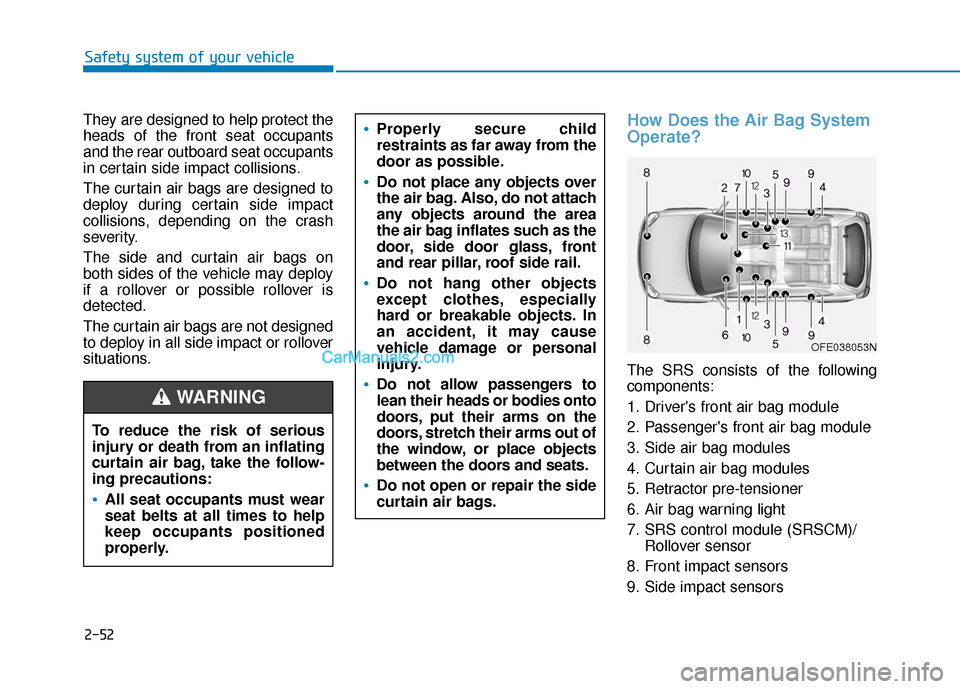
2-52
Safety system of your vehicle
They are designed to help protect the
heads of the front seat occupants
and the rear outboard seat occupants
in certain side impact collisions.
The curtain air bags are designed to
deploy during certain side impact
collisions, depending on the crash
severity.
The side and curtain air bags on
both sides of the vehicle may deploy
if a rollover or possible rollover is
detected.
The curtain air bags are not designed
to deploy in all side impact or rollover
situations.
How Does the Air Bag System
Operate?
The SRS consists of the following
components:
1. Driver's front air bag module
2. Passenger's front air bag module
3. Side air bag modules
4. Curtain air bag modules
5. Retractor pre-tensioner
6. Air bag warning light
7. SRS control module (SRSCM)/ Rollover sensor
8. Front impact sensors
9. Side impact sensors
To reduce the risk of serious
injury or death from an inflating
curtain air bag, take the follow-
ing precautions:
All seat occupants must wear
seat belts at all times to help
keep occupants positioned
properly.
Properly secure child
restraints as far away from the
door as possible.
Do not place any objects over
the air bag. Also, do not attach
any objects around the area
the air bag inflates such as the
door, side door glass, front
and rear pillar, roof side rail.
Do not hang other objects
except clothes, especially
hard or breakable objects. In
an accident, it may cause
vehicle damage or personal
injury.
Do not allow passengers to
lean their heads or bodies onto
doors, put their arms on the
doors, stretch their arms out of
the window, or place objects
between the doors and seats.
Do not open or repair the side
curtain air bags.
WARNING
OFE038053N
Page 83 of 560
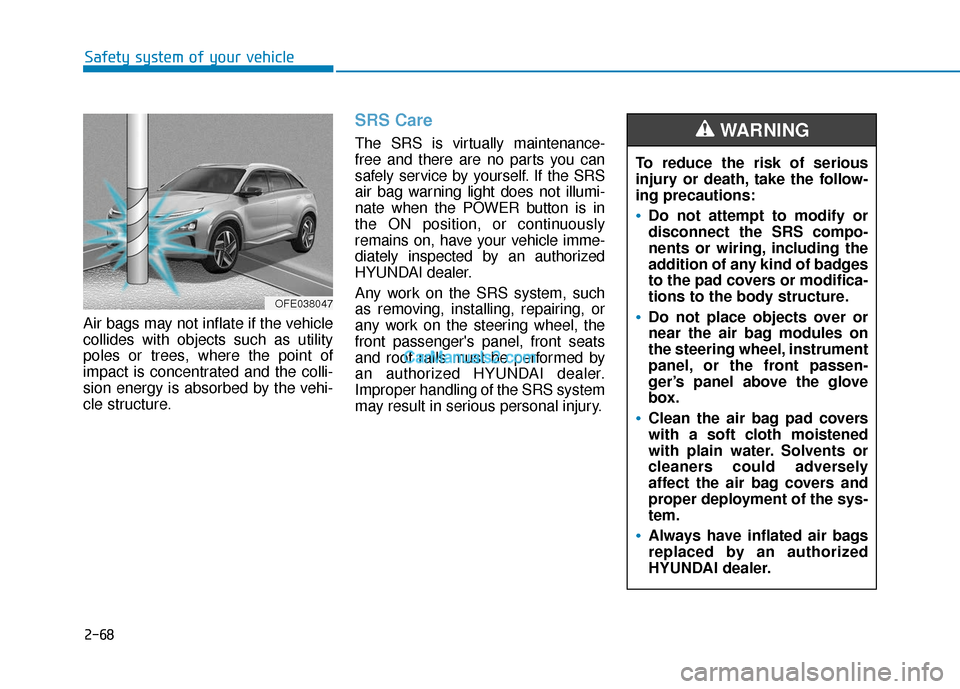
2-68
Safety system of your vehicle
Air bags may not inflate if the vehicle
collides with objects such as utility
poles or trees, where the point of
impact is concentrated and the colli-
sion energy is absorbed by the vehi-
cle structure.
SRS Care
The SRS is virtually maintenance-
free and there are no parts you can
safely service by yourself. If the SRS
air bag warning light does not illumi-
nate when the POWER button is in
the ON position, or continuously
remains on, have your vehicle imme-
diately inspected by an authorized
HYUNDAI dealer.
Any work on the SRS system, such
as removing, installing, repairing, or
any work on the steering wheel, the
front passenger's panel, front seats
and roof rails must be performed by
an authorized HYUNDAI dealer.
Improper handling of the SRS system
may result in serious personal injury. To reduce the risk of serious
injury or death, take the follow-
ing precautions:
Do not attempt to modify or
disconnect the SRS compo-
nents or wiring, including the
addition of any kind of badges
to the pad covers or modifica-
tions to the body structure.
Do not place objects over or
near the air bag modules on
the steering wheel, instrument
panel, or the front passen-
ger’s panel above the glove
box.
Clean the air bag pad covers
with a soft cloth moistened
with plain water. Solvents or
cleaners could adversely
affect the air bag covers and
proper deployment of the sys-
tem.
Always have inflated air bags
replaced by an authorized
HYUNDAI dealer.
WARNING
OFE038047
Page 89 of 560

Driver Assist System .........................................3-104
Parking Distance Warning (Reverse/Forward)
System ........................................................................\
.....3-104
Rear View Monitor .......................................................3-108
Surround View Monitoring .........................................3-109
Remote Smart Parking Assist (RSPA) .............3-112
Operating Condition......................................................3-113
Non-operating Condition ............................................3-114
Limitations of the System...........................................3-115
How the System Works (Smart Parking) ................3-119
How the System Works (Remote Smart Parking)..3-126
How the System Works (Smart Exit) .......................3-130
How the System Works (Remote Moving Forward/
Backward) .......................................................................3\
-137
Additional Instructions (Messages) ..........................3-142
Turn signal Showing Vehicle Status while System
in Activation....................................................................3-14\
3
Smart Key Showing Vehicle Status while System
in Activation....................................................................3-14\
4
Link with other Systems .............................................3-145
Automatic Climate Control System ..................3-146
Automatic Temperature Control Mode ....................3-147
Manual Temperature Control Mode .........................3-147
System Operation .........................................................3-154
System Maintenance....................................................3-155
Windshield Defrosting and Defogging ............3-157
Auto Defogging System (Additional Feature with
Automatic Temperature Control System)................3-159
Rear Window Defroster ..............................................3-160
Climate Control Additional Features ...............3-161
Automatic Ventilation ...................................................3-161
Sunroof Inside Air Recirculation ...............................3-161
Storage Compartment .......................................3-162
Center Console Storage ..............................................3-162
Glove Box ........................................................................\
3-162
Interior Features ................................................3-163
Cup Holder ......................................................................3-\
163
Sunvisor ........................................................................\
...3-164
Power Outlet ..................................................................3-165
AC Inverter......................................................................3-\
166
USB Charger ...................................................................3-168\
Wireless Cellular Phone Charging System..............3-168
Clock ........................................................................\
.........3-170
Coat Hook .......................................................................3\
-171
Floor Mat Anchor(s).....................................................3-171
Luggage Net Holder .....................................................3-172
Cargo Security Screen .................................................3-173
Exterior Features ...............................................3-175
Roof Side Rails ..............................................................3-175
3
Page 262 of 560
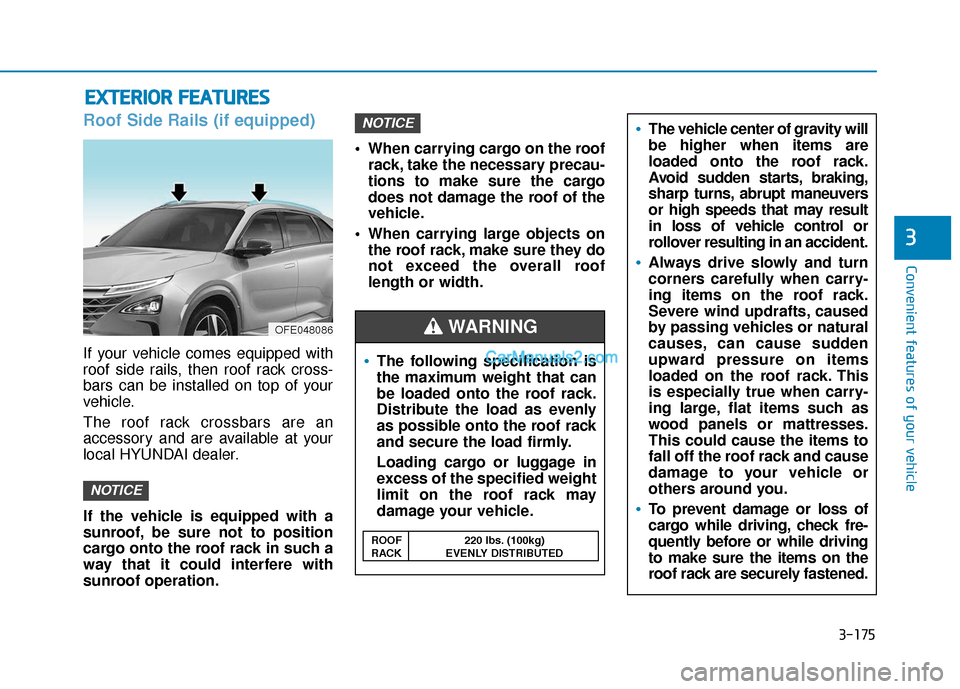
3-175
Convenient features of your vehicle
3
Roof Side Rails (if equipped)
If your vehicle comes equipped with
roof side rails, then roof rack cross-
bars can be installed on top of your
vehicle.
The roof rack crossbars are an
accessory and are available at your
local HYUNDAI dealer.
If the vehicle is equipped with a
sunroof, be sure not to position
cargo onto the roof rack in such a
way that it could interfere with
sunroof operation. When carrying cargo on the roof
rack, take the necessary precau-
tions to make sure the cargo
does not damage the roof of the
vehicle.
When carrying large objects on the roof rack, make sure they do
not exceed the overall roof
length or width.
NOTICE
NOTICE
E EX
X T
TE
ER
R I
IO
O R
R
F
F E
E A
A T
TU
U R
RE
ES
S
The following specification is
the maximum weight that can
be loaded onto the roof rack.
Distribute the load as evenly
as possible onto the roof rack
and secure the load firmly.
Loading cargo or luggage in
excess of the specified weight
limit on the roof rack may
damage your vehicle.
The vehicle center of gravity will
be higher when items are
loaded onto the roof rack.
Avoid sudden starts, braking,
sharp turns, abrupt maneuvers
or high speeds that may result
in loss of vehicle control or
rollover resulting in an accident.
Always drive slowly and turn
corners carefully when carry-
ing items on the roof rack.
Severe wind updrafts, caused
by passing vehicles or natural
causes, can cause sudden
upward pressure on items
loaded on the roof rack. This
is especially true when carry-
ing large, flat items such as
wood panels or mattresses.
This could cause the items to
fall off the roof rack and cause
damage to your vehicle or
others around you.
To prevent damage or loss of
cargo while driving, check fre-
quently before or while driving
to make sure the items on the
roof rack are securely fastened.
WARNING
ROOF 220 lbs. (100kg)
RACK EVENLY DISTRIBUTED
OFE048086
Page 431 of 560
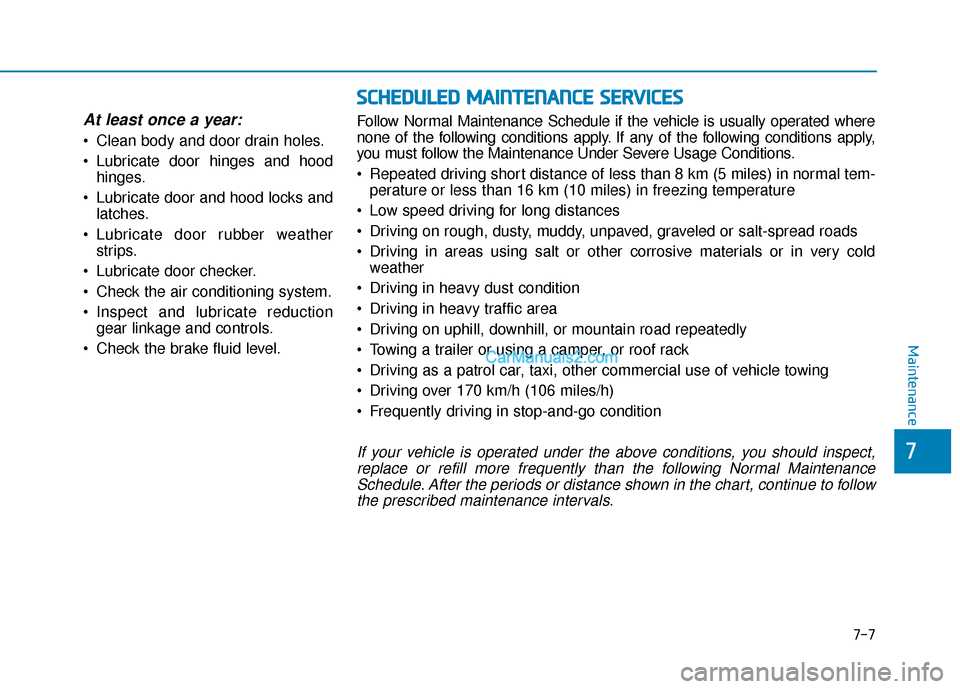
7-7
7
Maintenance
At least once a year:
• Clean body and door drain holes.
Lubricate door hinges and hoodhinges.
Lubricate door and hood locks and latches.
Lubricate door rubber weather strips.
Lubricate door checker.
Check the air conditioning system.
Inspect and lubricate reduction gear linkage and controls.
Check the brake fluid level.
S S C
C H
H E
ED
D U
U L
LE
E D
D
M
M A
AI
IN
N T
TE
EN
N A
AN
N C
CE
E
S
S E
E R
R V
V I
IC
C E
E S
S
Follow Normal Maintenance Schedule if the vehicle is usually operated where
none of the following conditions apply. If any of the following conditions apply,
you must follow the Maintenance Under Severe Usage Conditions.
Repeated driving short distance of less than 8 km (5 miles) in normal tem-
perature or less than 16 km (10 miles) in freezing temperature
Low speed driving for long distances
Driving on rough, dusty, muddy, unpaved, graveled or salt-spread roads
Driving in areas using salt or other corrosive materials or in very cold weather
Driving in heavy dust condition
Driving in heavy traffic area
Driving on uphill, downhill, or mountain road repeatedly
Towing a trailer or using a camper, or roof rack
Driving as a patrol car, taxi, other commercial use of vehicle towing
Driving over 170 km/h (106 miles/h)
Frequently driving in stop-and-go condition
If your vehicle is operated under the above conditions, you should inspect, replace or refill more frequently than the following Normal MaintenanceSchedule. After the periods or distance shown in the chart, continue to followthe prescribed maintenance intervals.
Page 435 of 560
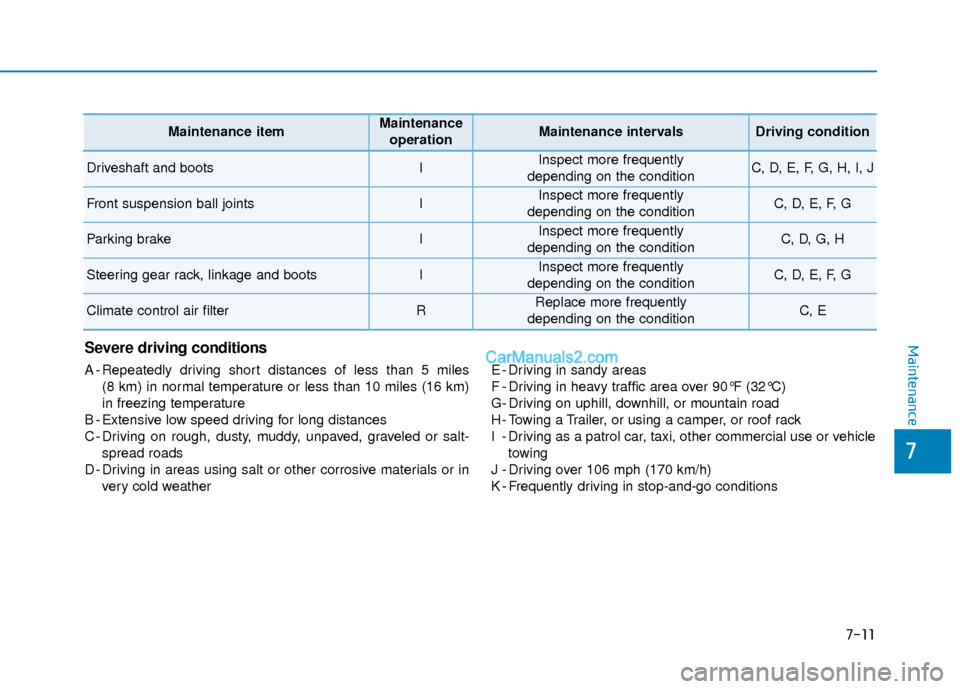
7-11
7
MaintenanceSevere driving conditions
A - Repeatedly driving short distances of less than 5 miles (8 km) in normal temperature or less than 10 miles (16 km)
in freezing temperature
B - Extensive low speed driving for long distances
C - Driving on rough, dusty, muddy, unpaved, graveled or salt- spread roads
D - Driving in areas using salt or other corrosive materials or in very cold weather E - Driving in sandy areas
F - Driving in heavy traffic area over 90°F (32°C)
G- Driving on uphill, downhill, or mountain road
H - Towing a Trailer, or using a camper, or roof rack
I - Driving as a patrol car, taxi, other commercial use or vehicle
towing
J - Driving over 106 mph (170 km/h)
K - Frequently driving in stop-and-go conditions
Maintenance itemMaintenance operationMaintenance intervalsDriving condition
Driveshaft and bootsIInspect more frequently
depending on the conditionC, D, E, F, G, H, I, J
Front suspension ball jointsIInspect more frequently
depending on the conditionC, D, E, F, G
Parking brakeIInspect more frequently
depending on the conditionC, D, G, H
Steering gear rack, linkage and bootsIInspect more frequently
depending on the conditionC, D, E, F, G
Climate control air filterRReplace more frequently
depending on the conditionC, E
Page 496 of 560
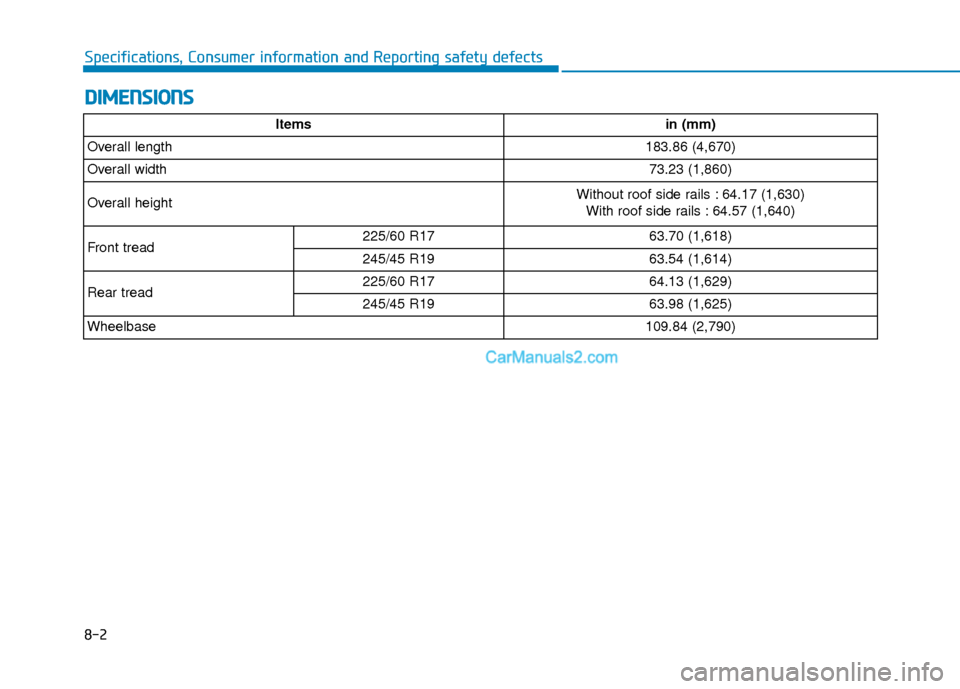
D
DI
IM
M E
EN
N S
SI
IO
O N
NS
S
8-2
Specifications, Consumer information and Reporting safety defects
Itemsin (mm)
Overall length183.86 (4,670)
Overall width73.23 (1,860)
Overall heightWithout roof side rails : 64.17 (1,630)
With roof side rails : 64.57 (1,640)
Front tread225/60 R1763.70 (1,618)
245/45 R1963.54 (1,614)
Rear tread 225/60 R1764.13 (1,629)
245/45 R1963.98 (1,625)
Wheelbase109.84 (2,790)
Page 553 of 560
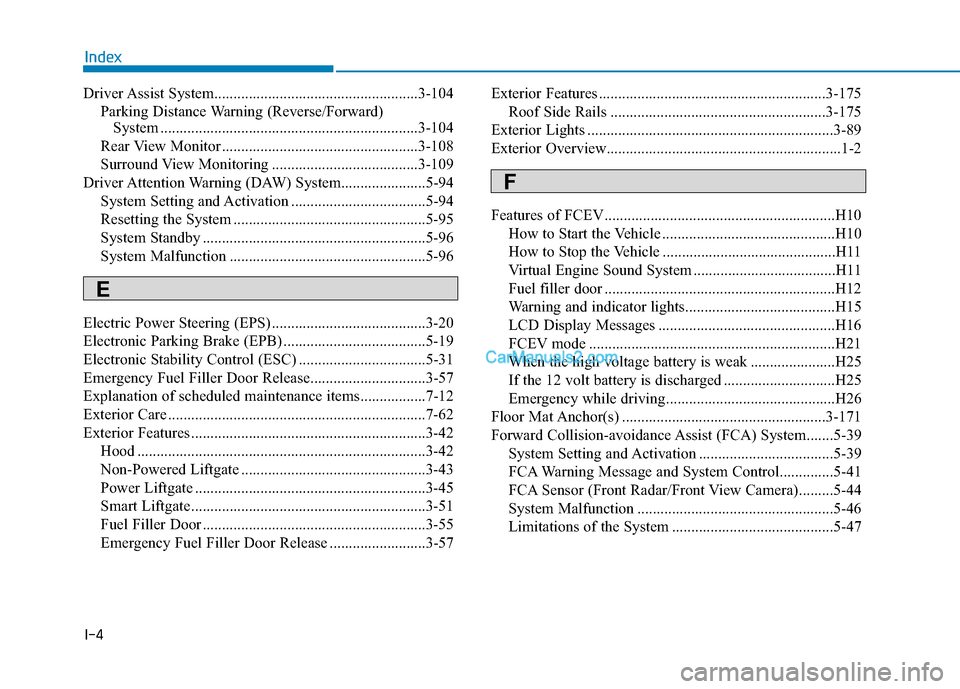
I-4
Driver Assist System.....................................................3-104Parking Distance Warning (Reverse/Forward) System ...................................................................3-104\
Rear View Monitor ...................................................3-108
Surround View Monitoring ......................................3-109
Driver Attention Warning (DAW) System......................5-94 System Setting and Activation ...................................5-94
Resetting the System ..................................................5-95
System Standby ..........................................................5-96
System Malfunction ...................................................5-96
Electric Power Steering (EPS) ........................................3-20
Electronic Parking Brake (EPB) .....................................5-19
Electronic Stability Control (ESC) .................................5-31
Emergency Fuel Filler Door Release..............................3-57
Explanation of scheduled maintenance items.................7-12
Exterior Care ...................................................................7-62
Exterior Features .............................................................3-42 Hood ........................................................................\
...3-42
Non-Powered Liftgate ................................................3-43
Power Liftgate ............................................................3-45
Smart Liftgate.............................................................3-51
Fuel Filler Door ..........................................................3-55
Emergency Fuel Filler Door Release .........................3-57 Exterior Features ...........................................................3-175
Roof Side Rails ........................................................3-175
Exterior Lights ................................................................3-89
Exterior Overview.............................................................1-2
Features of FCEV............................................................H10 How to Start the Vehicle .............................................H10
How to Stop the Vehicle .............................................H11
Virtual Engine Sound System .....................................H11
Fuel filler door ............................................................H12
Warning and indicator lights.......................................H15
LCD Display Messages ..............................................H16
FCEV mode ................................................................H21
When the high voltage battery is weak ......................H25
If the 12 volt battery is discharged .............................H25
Emergency while driving............................................H26
Floor Mat Anchor(s) .....................................................3-171
Forward Collision-avoidance Assist (FCA) System.......5-39 System Setting and Activation ...................................5-39
FCA Warning Message and System Control..............5-41
FCA Sensor (Front Radar/Front View Camera).........5-44
System Malfunction ...................................................5-46
Limitations of the System ..........................................5-47
Index
E
F
Page 557 of 560
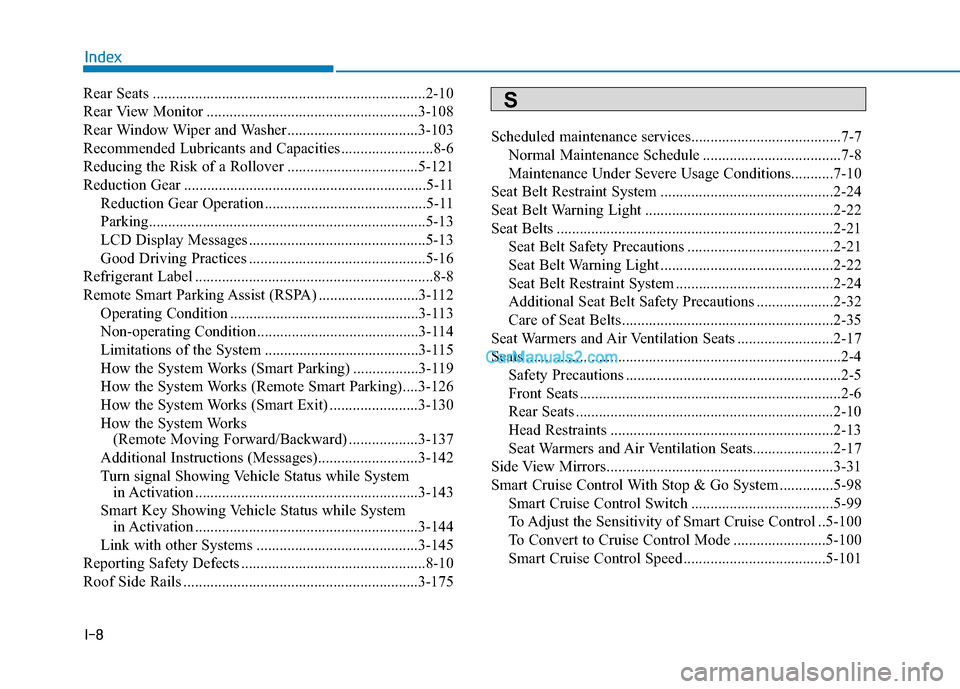
I-8
Rear Seats .......................................................................2\
-10
Rear View Monitor .......................................................3-108
Rear Window Wiper and Washer..................................3-103
Recommended Lubricants and Capacities ........................8-6
Reducing the Risk of a Rollover ..................................5-121
Reduction Gear ...............................................................5-11Reduction Gear Operation ..........................................5-11
Parking........................................................................\
5-13
LCD Display Messages ..............................................5-13
Good Driving Practices ..............................................5-16
Refrigerant Label ..............................................................8-8
Remote Smart Parking Assist (RSPA) ..........................3-112 Operating Condition .................................................3-113
Non-operating Condition ..........................................3-114
Limitations of the System ........................................3-115
How the System Works (Smart Parking) .................3-119
How the System Works (Remote Smart Parking)....3-126
How the System Works (Smart Exit) .......................3-130
How the System Works (Remote Moving Forward/Backward) ..................3-137
Additional Instructions (Messages)..........................3-142
Turn signal Showing Vehicle Status while System in Activation ..........................................................3-143
Smart Key Showing Vehicle Status while System in Activation ..........................................................3-144
Link with other Systems ..........................................3-145
Reporting Safety Defects ................................................8-10
Roof Side Rails .............................................................3-175 Scheduled maintenance services.......................................7-7
Normal Maintenance Schedule ....................................7-8
Maintenance Under Severe Usage Conditions...........7-10
Seat Belt Restraint System .............................................2-24
Seat Belt Warning Light .................................................2-22
Seat Belts ........................................................................\
2-21 Seat Belt Safety Precautions ......................................2-21
Seat Belt Warning Light .............................................2-22
Seat Belt Restraint System .........................................2-24
Additional Seat Belt Safety Precautions ....................2-32
Care of Seat Belts .......................................................2-35
Seat Warmers and Air Ventilation Seats .........................2-17
Seats ........................................................................\
..........2-4 Safety Precautions ........................................................2-5
Front Seats ....................................................................2-6
Rear Seats ...................................................................2-10
Head Restraints ..........................................................2-13
Seat Warmers and Air Ventilation Seats.....................2-17
Side View Mirrors...........................................................3-31
Smart Cruise Control With Stop & Go System ..............5-98 Smart Cruise Control Switch .....................................5-99
To Adjust the Sensitivity of Smart Cruise Control ..5-100
To Convert to Cruise Control Mode ........................5-100
Smart Cruise Control Speed .....................................5-101
Index
S